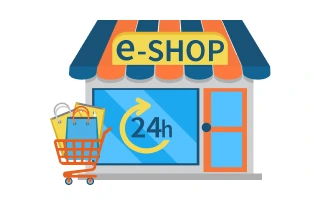Subscribe and you will promptly receive new published articles from the blog by mail
How to plot your strategy for success
To build a successful business, you need first to understand how success is to be measured – without this understanding, everything you invest in your project could be for nothing. And when you’re investing your most valuable asset – your time – you can’t afford to take unnecessary chances.
When Amazon founder Jeff Bezos received a proposal to place ads on the main page of his marketplace, he called it “one of the stupidest ideas I’ve ever heard”. But later, the boss of the world’s biggest e-commerce marketplace changed his mind about the idea – and today the company earns some $2.2bn annually from just this revenue stream. In 2024, Amazon’s advertising services generated $56.2 billion in revenue, with a projected annual run rate of $69 billion, marking a substantial increase from previous years. What made Bezos reconsider? Well, it wasn’t a sudden religious epiphany – rather, data the company had compiled simply showed that the numbers in favor of such a move were now too strong to ignore.
Marketplaces are powerful and scalable – that’s what fascinates us about them. They cover virtually every aspect of the modern economy. Highly liquid and extremely profitable, they can offer us anything: from a home massage to an apartment halfway around the world.
Creating a marketplace with the potential for success is no easy task – but we at Roobykon have spent more than eight years perfecting the art of building marketplace platforms. Along the way, our experts have accumulated a huge battery of expertise in the field – and in this article, we’d like to share some of what we’ve learned about just how best to take measure of your marketplace.
How do you know if your marketplace is successful?

No two marketplaces are identical – but despite the huge differences in business models that exist between them, each one has at its core some of the same key metrics. To build a world-class marketplace, you must understand what these are and how to interpret them: success can, and must, be measured. Analytics systems, data tracking, and the in-depth study of key indicators are all central to the success of behemoths like Airbnb, Amazon, Etsy, and Uber – and they will be key to your success, too.
The marketplace model of doing business calls for considerable nuance in measuring your project’s performance. You might think that if your platform has a base of returning visitors delivering a steady rise in e-commerce transactions, then your conversion funnel must be working fine (and you must be on track for success). But achieving long-term performance is not as simple as that. To truly understand whether you’re headed for boom or bust there are certain ‘key performance indicators’ – marketplace KPIs – that must be closely monitored and understood.
In this article, we’ll focus on those KPIs most vital for marketplace success. We’ll look at the situation not just from an entrepreneur’s perspective, but also from that of your users – because, as we all know, if your buyers and sellers aren’t happy, you’re not going anywhere.
Key metrics of marketplace success

There are many different measurable metrics out there: some are truly important, while others serve more to soothe your ego or distract you from what really matters. This article will help you identify – and focus on – the former group.
Business growth and profitability
To see how good your marketplace really is, start by taking the measure of its trade flow. Gross Merchandise Volume (or GMV) is the overall value of the products and services sold on a marketplace within a specified period – and a major indicator for retail-focused online businesses. But be sure to consider the particularities of your business model. If, for example, your income comes from commission fees, you’d better monitor GTV (Gross Transaction Value) instead – because while GMV helps to estimate the volume of a marketplace, it doesn’t tell you about the value that you as the marketplace owner are gaining from what’s going on.
Equally worthy of note is that service marketplaces (where clients buy services, not products) are well advised to separate ‘contracted’ and ‘real’ GMV – and to remember that these two figures can differ significantly. They also need to take into account all their canceled and refunded purchases when determining turnover.
Main formulas:
GMV = total number of transactions * AOV (average order value)
GTV = total number of transactions * AOV * Take Rate (your percentage from each transaction)
Net Profit (NP) is also an important indicator. Remember that it should be measured only after all expenses have been counted.
NP = TR (total revenue) – TC (total cost = cost of goods sold (COGS) + operational expenses (OpEx))
Example: a company has an annual revenue of $300,000; its marketing expenses amount to $100,000 and its operating expenses are $40,000.
In this case, NP = $300,000 – ($110,000 + $40,000) = $150,000
Once you’re done calculating NP, compare the number you get against your TC.
NP = $150,000; TC = $150,000
When net profit equals total cost, you’re at the point of covering your expenses – but not actually making any profit.
NP > TC – a profitable marketplace – i.e., making more than it spends
NP = TC – a marketplace that’s broken even but isn’t yet in profit
NP < TC – a marketplace that is losing money
It’s vital to accurately identify those segments in which you’re a leader – and whether your path to scale runs through an already-established market (like Deliveroo’s did), or entails developing a new niche (like Airbnb had to).
Liquidity
Liquidity – the number of transactions made on your platform – is one of the key characteristics of any successful two-sided marketplace. To function effectively, your marketplace will require a ‘critical mass’ of transactions and a balance of buyers and sellers. Maintaining that balance will be a matter of immense subtlety.
So, let’s say you’ve attracted a sufficient base of users to your platform. What next? Well, it’s essential to take care of the interactions that take place between them – because the prosperity of any two-sided marketplace depends entirely on the active engagement of both transaction participant groups. Accordingly, this means that you need to measure and assess two distinct indicators of liquidity: customer liquidity, and seller liquidity.
Breaking that down a bit – seller liquidity measures the percentage of listings that lead to successful transactions over a given period of time. But of course, exactly what this means depends on the nature of your sellers. In Etsy’s case, it means the percentage of the total stockpile sold – whereas for Airbnb it’s the number of apartments rented out over a 24-hour period. In Uber’s example, seller liquidity refers to the percentage of drivers who have carried out their contracts over the course of a particular hour.
Meanwhile, client liquidity usually refers to the percentage of visitors to your platform who end up completing a transaction. In general, if you’re scoring over 30%, you’re doing well – but it’s as well to ensure that you have a system in place to filter out sellers viewing their own listings from your stats.
Of course, the internal dynamics of your marketplace depend on a whole host of other metrics besides these. Prominently positioned among these are the buyer-seller ratio (the number of buyers a single seller is able to serve) and repeat purchase rate.
No single value exists to measure buyer-seller ratio – this is a KPI whose precise details depend on the type of marketplace you’re running. So it is that in the real estate sector, 1:1 is considered a good ratio – while in other markets you might be looking at a number closer to 1:10,000.
On the other hand, the repeat purchase rate is quite simple – the higher your rate, the better you’re doing. This is a metric that both measures the satisfaction of the users of your platform and puts you on a path towards sustainable customer acquisition resource allocation.
Etsy, for its part, managed to reach a 78% repeat purchase rate. This is as good an explanation as any as to why it has been so successful in achieving international name recognition.
Trust and safety

As they make their way through transactions, marketplace users face multiple risks – and so building trust is critical to keeping customers and vendors onboard. Airbnb is again a good example of how to do this right: users on both sides of its transactions put a great deal on the line in doing business with each other, but thanks to scrupulous supervision, it’s only very seldom that anything goes seriously wrong.
Well-thought-out identity verification; a detailed feedback system; efficient means of communication between users; swift problem resolution; robust anti-fraud measures – a lot goes into making users feel like they’re in a trustworthy space. But the results – in terms of problems avoided and users attracted and retained – are more than worthwhile.
From the outset of your project, you should identify metrics that will enable you to measure trust. Remember: many users will first arrive on your site as no more than curious passers-by, and your job is to make them feel like the space beyond your shop window is one into which they are safe to venture.
Return on investment
Commonly abbreviated to ROI, this is the financial indicator that tells you what you’re getting back from the money you pay out to advertise and promote your marketplace – and more specifically, how much revenue you can expect to generate when you direct resources into a particular marketing channel.
ROI is calculated by dividing the sales uplift generated by a particular marketing effort by what it cost you – and then multiplying the resulting number by 100%. If the final number is 100 or higher, your investment has paid off.
It’s important to remember that in the early days of your project, your ROI numbers are likely to come out negative. Fear not: if your marketplace has been thoughtfully planned and diligently set up, they should tip the right side of the line with a few months.
Remember, though, that quantitative metrics like ROI, though a crucial part of your KPI mix, can only tell you so much. They can tell you when things are going right (and when they’re not), but they don’t offer any ready solution as to how to correct your direction of travel.
If you’ve begun to see income flowing into your marketplace, but can’t identify precisely what has caused this, your chances of success are not high. To secure the long-term growth of your marketplace it’s crucial to invest serious effort in establishing which of your efforts are yielding results.
User acquisition and retention
It goes without saying that users are the key ingredient of any marketplace’s success – and the task of understanding how many you have and what motivates their behavior must be undertaken with utmost seriousness. Knowledge of your target audience itself adds value to what you have to offer – because users benefit from interacting with a platform that truly understands their needs.
So, just where to pick up your next 10 customers? For many entrepreneurs starting out, this simple question is a real quandary. As such, it’s important to be aware not just of the channels from which users flow, but also of the following metrics:
Customer acquisition cost
Simply put, this is how much you spend to bring each new customer onto your platform; CAC helps calculate advertising campaigns’ efficiency and pinpoint the most productive marketing channels for your marketplace.
The formula:
Customer Acquisition Cost = total marketing spend/number of conversions
Churn rate
This is the number that tells you what proportion of your users have abandoned your marketplace – it’s sometimes referred to as customer flight. Depending on the nature of your business this could mean subscription cancellation, account closure, or simply the cessation of activity. A high rate of churn is a worrying sign for any marketplace.
But churn rate is often viewed as a somewhat controversial KPI – not least because its precise significance changes considerably as your marketplace moves through its journey. In the early stages of your business, a 10% monthly churn rate mightn’t look so dangerous – 10% of 100 users means that just 10 people were lost, while you retained 90 regular customers. If you only need to find 10 more customers to stay level, you can plausibly tell yourself that there are plenty more fish in the sea.
But as the absolute numbers involved get bigger, the risk grows of depleting your total pool of potential customers. A churn rate of 10% on a user base of 10,000 means a thousand users lost each month – and eventually, there may not be enough demand left in the market to replace them.
While early-stage entrepreneurs may comfort themselves that this is something that can be resolved as their numbers grow, experienced marketplace owners would caution them that complacency over churn is something that must be carefully checked from the outset.
Lifetime value
Not every customer who completes a transaction has the same eventual value to your business – rather, each falls somewhere on your so-called COCA (or Cost of Customer Acquisition)index. The upshot is that it’s ultimately better to have a smaller number of highly active and loyal customers than lots of low-value, occasional ones.
Customer satisfaction
Knowing how satisfied your customers are feeling with your platform is key to understanding its health as a business – because when users become unhappy, they are likely not only depart but also to leave a toxic trail of negative feedback in their wake, multiplying the damage of their dissatisfaction.
Two main methods exist to evaluate customer satisfaction: Net Promoter Score (NPS) and the Sean Ellis Test.
The NPS method is based on responses to a simple question: How likely is it that you would recommend [our product] to a friend or colleague? The answer is usually expressed on a scale from 0-10, with responses typically grouped into three bands:
9-10: Users likely be active and to recommend your platform to others
7-8: Passive users who are satisfied enough but unlikely to recommend you
0-6: More-or-less dissatisfied users who, if given the opportunity, are likely to negatively influence your brand by leaving bad feedback.
A differential of more than 0 between satisfied and dissatisfied users is generally considered satisfactory. Once that number rises to 50 or more, you can usually say you’re doing very well.
The Sean Ellis Test is based on a different question: How would you feel if you could no longer use [our] product? The three possible responses are:
- Very disappointed
- Somewhat disappointed
- Not disappointed
If 40% of users respond that they’d be ‘very disappointed’, your marketplace can be said to be meeting typical expectations.
Overall, our view is that combining both these tests will give you the most accurate picture of how users are feeling about your marketplace.
Don’t feed your ego

Being in business is like living in a fish tank: almost everything you do happens in the open, for all to see. But paradoxically, the ones we do sometimes manage to hide important truths from being ourselves – because we all naturally prefer to focus on good news rather than bad.
Most metrics can be divided into those that deliver hard, important truths and those that feed vanity. Your number of registered users probably falls into the second category – because registrations cost users nothing, and mean nothing to you if those users remain inactive. Likewise, a high average page-view count per session isn’t worth much if it’s not translating to high-value transactions.
Vanity metrics must be sidelined at all costs if you are to have the clear-eyed picture your business needs to move forward. They may give you a brief glow of satisfaction, but they will never show you the correct way ahead.
Ways of working with performance indicators
Of course, accurately measuring your KPIs will be of no use if you don’t use the data you gather to the maximum possible effect. Broadly speaking, there are three ways to put your metrics to work:
- Regular preventive monitoring. Necessary even when you occupy a successful and seemingly stable position in the market, preventative monitoring helps you spot problems in their infancy and stop them in their tracks – and focus your resources where they’ll generate profit.
- Solving existing problems. Seemingly trivial issues can have a nasty habit of eventually growing into major obstacles – use your data to stop problems from progressing before users begin to flee.
- Achieving your goals. Analytics tools are there to measure the effectiveness of your actions – and in their most long-term-focused role, KPIs are there to let you guide the strategy of your marketplace onto the most effective course.
How users measure your success
Remember that the things your marketplace users value may not be the same things you do. Their measures of success may not be the same as yours. Of course, you must ultimately meet your own business goals – but in order to get there, you need to know what your users want from you. Success comes when everyone involved is getting what they need.
For customers, your marketplace is as successful as it is useful to them – the size of your profits or your marketing budget is immaterial. As such, you should never take the customers you have already acquired for granted; rather, you must show how much you value them by offering the best in user experience, data safety, convenience, value, and support. Your responsiveness to their individual needs is what will make your marketplace stand out in the eyes of the people who might spend money there.
Unsurprisingly, then, the success of a marketplace from its sellers’ perspective is equal to the success they achieve through that platform. Provide them with all they need for growth and conversion within your marketplace, facilitate secure and seamless interaction with buyers, and ensure a steady supply of prospective customers – and your sellers will likely prosper.
Do you want to create a successful marketplace?
Do you want to build your own business from scratch? Are you thinking of entering the fray of an existing niche – or do you have a new direction to carve out? Maybe you already have a marketplace but want it to perform better? Whichever it is, we’d love to hear from you. At Roobykon Software we have an eight-year history of building marketplace platforms – combining trusted expertise with the latest technological developments to give your business the best possible chance of success.
Get a quote today.
Recommended articles
 How your B2B marketplace can utilize machine learning and AI
How your B2B marketplace can utilize machine learning and AIRead about how your B2B B2B market can use machine learning and AI: User verification, Product and service recommendations, Logistics management and other in this article
 SEO For Marketplaces
SEO For Marketplaces➥ About SEO marketplace. There are our points to starting and improving marketplace seo. Roobykon Software's qualified in this, gives own huge experience to your business
 Online Healthcare and Wellness Services Marketplace: How To Build And Promote
Online Healthcare and Wellness Services Marketplace: How To Build And PromoteBuilding a healthcare marketplace involves more than just a website. Discover how to plan, develop, and implement the best strategies for creating a flawless online platform for health and wellness services.
 7 Reasons People Are Afraid of eCommerce and How to Deal with Them
7 Reasons People Are Afraid of eCommerce and How to Deal with ThemWhile eCommerce has revolutionized the retail industry, it has also given rise to various fears among potential shoppers. This article explores seven major reasons why consumers are wary of eCommerce.






